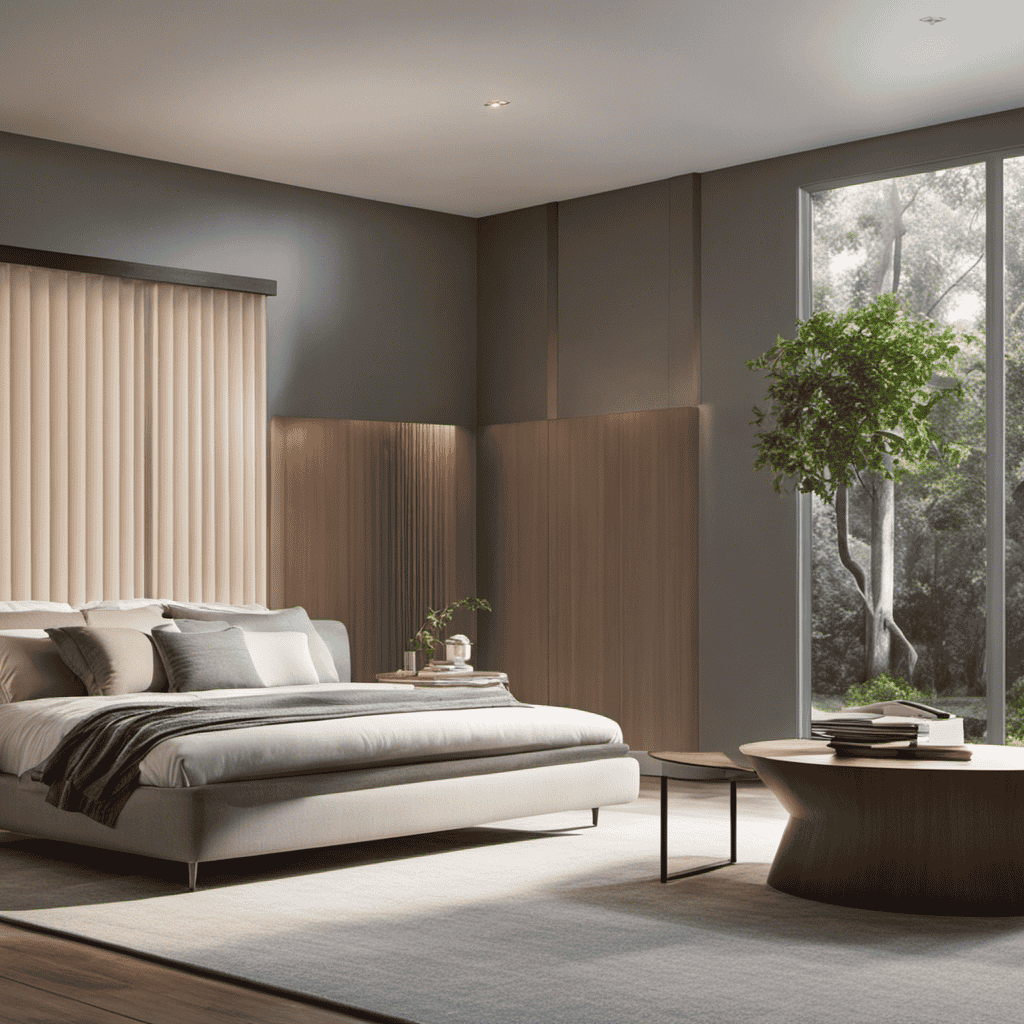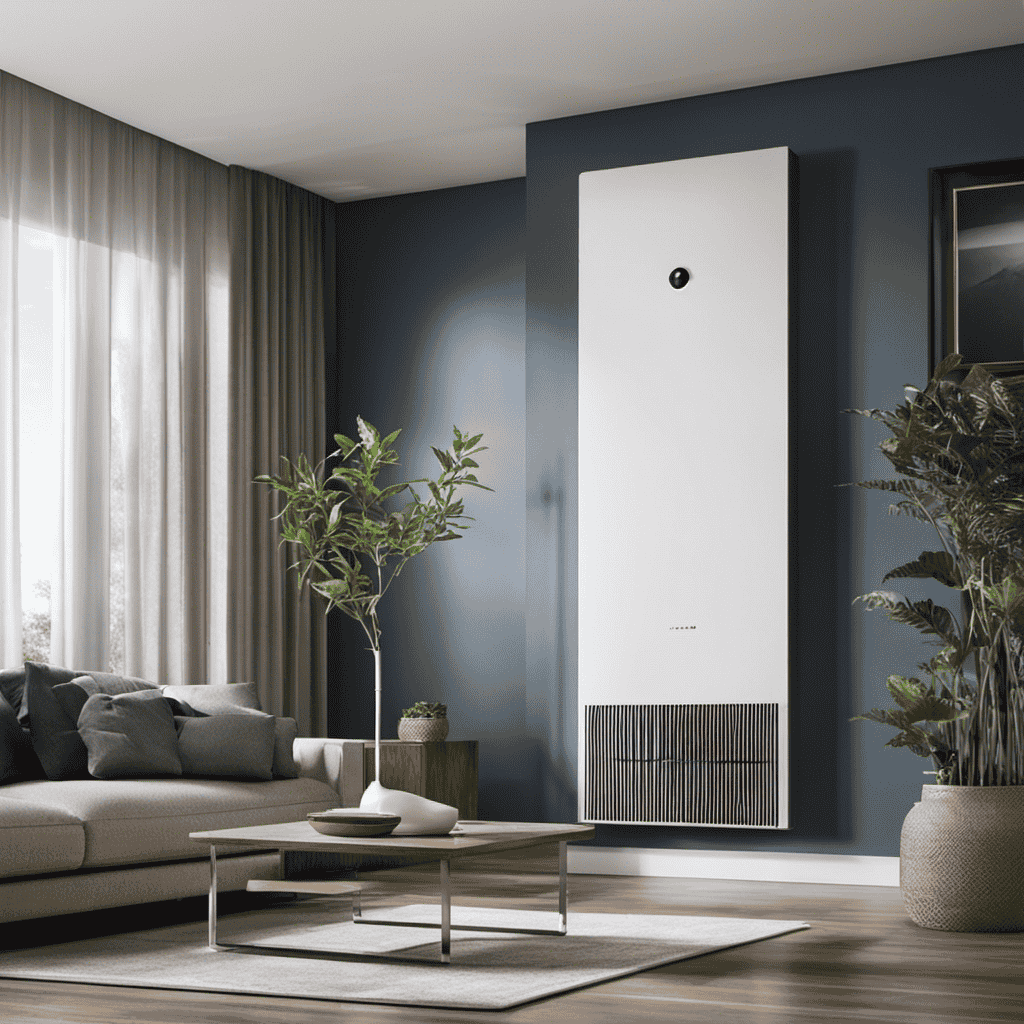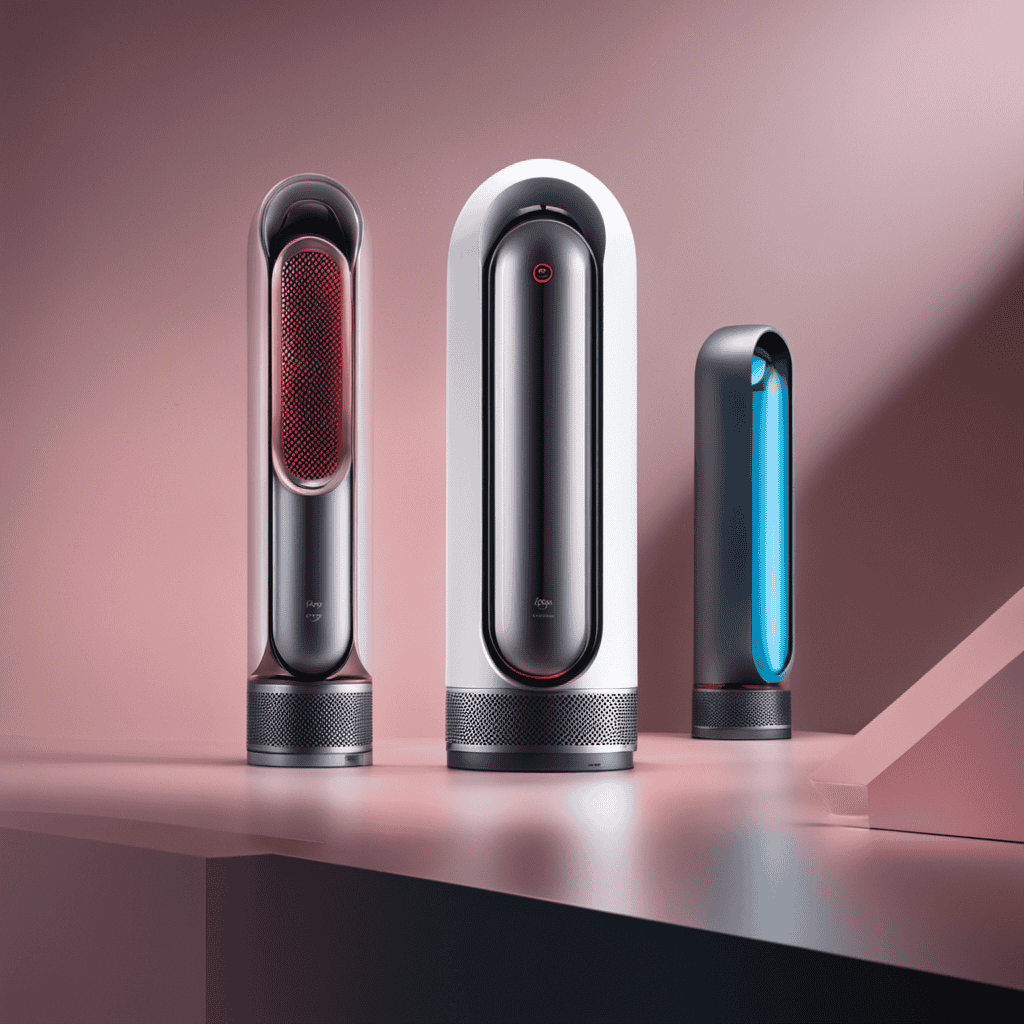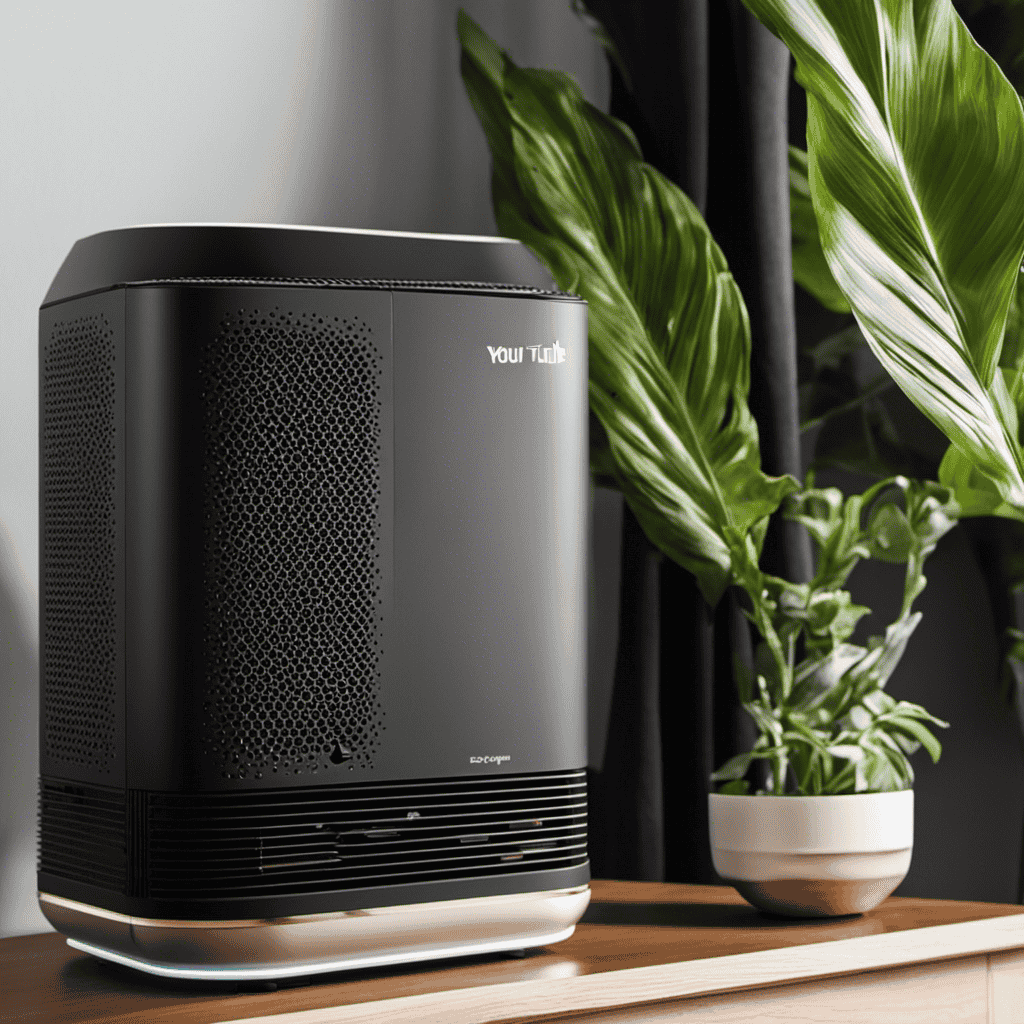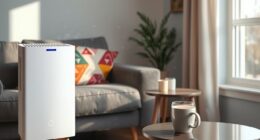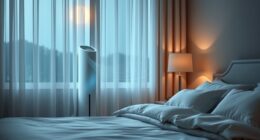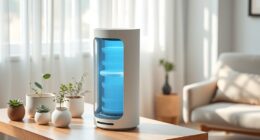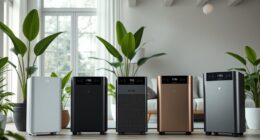As someone who studies air purification, I can attest that discovering a reliable air purifier is akin to finding a breath of fresh air in a contaminated environment.
But just how long does it take for an air purifier to work its magic?
In this article, we will delve into the factors that influence an air purifier’s effectiveness, from room size to filter types.
So sit back, relax, and let’s explore the timeline for optimal air purification.
Key Takeaways
- The effectiveness of an air purifier depends on factors such as room size, pollutant type, and airflow rate.
- Proper placement of the air purifier is crucial for maximum impact on air purification.
- The quality of the air purifier filter affects its lifespan and overall effectiveness.
- Air purifiers are not an instant solution and may take time to noticeably improve air quality.
Factors Affecting Air Purifier’s Effectiveness
Factors like room size, air quality, and the specific model of your air purifier can affect how quickly it starts working.
When it comes to room size, it plays a crucial role in the air purifier’s performance. A larger room requires a more powerful air purifier to effectively clean the air. This is because a larger room has more air volume, which means the air purifier needs to work harder and for a longer period of time to clean the entire space.
Additionally, proper room ventilation is important for the air purifier to work efficiently. Good airflow allows the purifier to circulate the air and capture more pollutants. On the other hand, poor ventilation can limit the purifier’s effectiveness.
Another factor to consider is the noise level of the air purifier. Some models can be quite loud, and this may affect your comfort level while the purifier is running.
In the next section, we will explore the role of room size in more detail and its impact on the air purifier’s overall performance.
The Role of Room Size in Air Purifier’s Performance
The size of the room directly affects how well an air purifier performs. When choosing an air purifier, it is crucial to consider the dimensions of the room where it will be used. Here are four ways in which room size impacts air purifier performance:
-
Coverage Area: Air purifiers are designed to clean a specific area, usually measured in square feet. If the room is larger than the purifier’s coverage area, it will struggle to effectively clean the air.
-
Air Exchange Rate: The size of the room determines how quickly the purifier can exchange the air. A larger room requires a higher air exchange rate to maintain clean air.
-
Purifier Size: A larger room may require a larger air purifier with a higher Clean Air Delivery Rate (CADR) to handle the increased air volume.
-
Efficiency: The efficiency of an air purifier decreases as the room size increases. A purifier designed for smaller spaces may not be as effective in larger rooms.
Understanding Air Purifier Filter Types and Their Impact
When it comes to air purifiers, understanding the effectiveness and lifespan of filters is crucial.
Filters play a major role in trapping and removing airborne particles, such as dust, pollen, and pet dander, from the air.
Additionally, filters can impact the overall air quality in a room by reducing the concentration of pollutants and improving the indoor environment.
Filter Effectiveness and Lifespan
To get the most out of your air purifier, make sure to regularly check and replace the filter as needed. The effectiveness and lifespan of an air purifier filter are crucial factors in maintaining the longevity of the device and minimizing filter replacement costs. Here are four key points to consider:
-
Filter Quality: Invest in high-quality filters that are designed to capture a wide range of pollutants, such as dust, pollen, pet dander, and smoke. These filters are more effective and have a longer lifespan.
-
Filter Lifespan: The lifespan of an air purifier filter depends on various factors, including the air quality in your environment and the amount of usage. On average, filters need to be replaced every 6-12 months.
-
Regular Maintenance: Regularly clean and maintain your air purifier to prolong the lifespan of the filter. Follow the manufacturer’s instructions for cleaning and maintenance.
-
Cost Considerations: While high-quality filters may have a higher initial cost, they often last longer, reducing the overall filter replacement cost over time.
Impact on Air Quality
Regularly checking and replacing the air purifier filter is essential for maintaining clean indoor air. Room ventilation plays a crucial role in maintaining air quality standards. According to research, air purifiers can significantly improve air quality by removing airborne pollutants like dust, pollen, and pet dander. The effectiveness of an air purifier in improving air quality depends on factors such as the size of the room, the type of pollutants present, and the purifier’s airflow rate. To better understand the impact of air purifiers on air quality, refer to the table below:
| Room Size | Air Purifier Capacity | Air Changes per Hour |
|---|---|---|
| Small | 200 sq. ft. | 4 |
| Medium | 400 sq. ft. | 2 |
| Large | 800 sq. ft. | 1 |
| Extra-Large | 1000+ sq. ft. | 0.5 |
| Open Plan | Varies | Varies |
How Long Does It Take to Notice a Difference in Air Quality
You’ll start noticing a difference in air quality fairly quickly after using an air purifier. The time it takes for noticeable improvements can vary depending on several factors such as the size of the room, the level of air pollution, and the efficiency of the air purifier itself. However, on average, you can expect to see improvements within a few hours to a couple of days.
Here’s a breakdown of the timeline:
-
Immediate effects: Once you turn on the air purifier, it starts removing pollutants from the air immediately. You may notice a fresher smell and a reduction in dust particles.
-
Short-term improvements: Within a few hours, the air quality should start improving noticeably. This can be measured using air quality monitoring devices, which can detect a decrease in pollutants.
-
Gradual enhancement: Over the next day or two, the air purifier will continue to work, gradually reducing the levels of pollutants, allergens, and other contaminants.
-
Maintaining clean air: To maintain optimal air quality, it is recommended to run the air purifier continuously and regularly clean or replace its filters.
The Importance of Air Purifier Placement
When considering the importance of air purifier placement, it’s crucial to position it in an area where it can effectively circulate and clean the air in your space. Proper air purifier placement plays a significant role in improving air quality.
Research has shown that strategic placement of air purifiers can lead to better results in terms of air purification. Placing the air purifier in the center of the room allows it to have the maximum impact, as it can efficiently circulate the air and capture pollutants from all directions. It is also essential to keep the air purifier away from walls and furniture to ensure unobstructed airflow.
By following these placement guidelines, you can optimize the performance of your air purifier and achieve significant air quality improvement.
Transitioning into the next section, let’s explore whether air purifiers can remove allergens and pollutants instantly.
Can Air Purifiers Remove Allergens and Pollutants Instantly
In this discussion, I will explore the effectiveness of air purifiers in instantly removing allergens and pollutants from the air.
Research has shown that certain types of air purifiers, such as those equipped with HEPA filters, are capable of capturing and removing allergens like dust mites, pollen, and pet dander.
However, the time it takes for an air purifier to completely eradicate pollutants will vary depending on factors such as the size of the room and the level of pollution present.
Instant Allergen Removal
For instant relief from allergens, simply turn on the air purifier and let it do its magic. Air purifiers are designed to remove allergens and pollutants from the air, providing a cleaner and healthier environment.
Here are four key factors that contribute to the air purification efficiency of an air purifier:
-
Filtration System: A high-quality air purifier has a multi-stage filtration system that can capture and remove various allergens, including dust, pollen, pet dander, and mold spores.
-
CADR Rating: The Clean Air Delivery Rate (CADR) measures how effectively an air purifier can remove specific pollutants. Look for an air purifier with a high CADR rating for the best results.
-
Room Size: The size of the room plays a crucial role in the air purification efficiency. It’s important to choose an air purifier that is suitable for the size of the room to ensure optimal performance.
-
Maintenance: Regular maintenance, such as replacing filters and cleaning the unit, is essential for maintaining the air purification efficiency of an air purifier.
Pollutant Eradication Time
To ensure pollutants are eradicated efficiently, it’s important to choose an air purifier with a high CADR rating and a multi-stage filtration system that captures and removes various allergens.
The pollutant removal time of an air purifier depends on several factors. These factors include the size of the room, the level of pollutants present, and the effectiveness of the air purifier itself.
A high CADR rating indicates that the air purifier can remove pollutants at a faster rate. The multi-stage filtration system plays a crucial role in capturing and removing different types of allergens, such as dust, pollen, and pet dander. The more stages the filtration system has, the more effectively it can remove pollutants.
It’s important to consider these factors when selecting an air purifier to ensure efficient pollutant eradication.
Air Purifier Effectiveness?
The effectiveness of an air purifier can be determined by its CADR rating and the number of stages in its filtration system. Here are some key factors to consider when evaluating the effectiveness of an air purifier:
-
CADR rating: The Clean Air Delivery Rate (CADR) measures how quickly the air purifier can remove pollutants from the air. A higher CADR rating indicates a more effective air purifier.
-
Filtration stages: The number of stages in the filtration system determines the level of pollutants that can be captured. A multi-stage filtration system can effectively remove a wide range of pollutants.
-
Air purifier noise level: The noise level of an air purifier is an important consideration, especially if you plan to use it in a bedroom or office. Look for air purifiers with a low noise level for a quiet and undisturbed environment.
-
Air purifier energy consumption: Energy-efficient air purifiers can help reduce electricity costs. Look for air purifiers with an Energy Star certification to ensure optimal energy consumption.
Considering these factors will help you choose an air purifier that is both effective in purifying the air and suitable for your specific needs.
Now let’s explore how air purifier technology influences the speed of results.
How Does Air Purifier Technology Influence Speed of Results
If you’re wondering how air purifier technology affects the speed of results, you’ll be pleased to know that newer models are designed to work more efficiently.
Air purifier technology advancements have made significant progress in recent years, improving the speed at which they can clean the air in our homes and workplaces. This is especially important considering the impact of air pollution on our health.
According to research, exposure to indoor air pollutants can lead to various health issues, such as respiratory problems, allergies, and even cardiovascular diseases.
By utilizing advanced filtration systems and enhanced airflow designs, modern air purifiers can remove a higher volume of harmful particles from the air in a shorter amount of time.
These advancements in technology have resulted in faster and more effective air purification, ultimately providing us with cleaner and healthier indoor environments.
The Relationship Between Air Purifier’s CADR and Performance Time
When choosing an air purifier, you’ll want to consider the Clean Air Delivery Rate (CADR) rating as it directly relates to how quickly the unit can clean the air in your space. The CADR rating measures the volume of clean air produced by the purifier within a specific time frame. A higher CADR rating indicates that the unit can clean the air faster.
Here are four important points to consider regarding the relationship between CADR and performance time:
-
CADR rating: Look for a purifier with a high CADR rating to ensure faster air cleaning.
-
Room size: Consider the CADR rating in relation to the size of your room for optimal performance.
-
Noise levels: Some air purifiers may produce noise while operating. Check the noise level specifications to choose a unit that meets your preferences.
-
Energy consumption: Higher CADR ratings may consume more energy. Be mindful of energy efficiency when making your selection.
Air Purifier Maintenance: Impact on Efficiency and Speed of Work
When it comes to air purifier maintenance, two key points to consider are cleaning frequency and effectiveness, as well as filter replacement timeframes.
Research has shown that the frequency at which an air purifier is cleaned can have a significant impact on its efficiency and speed of work.
Additionally, knowing when to replace the filters is crucial to ensure that the air purifier continues to function effectively and provide clean air.
Cleaning Frequency and Effectiveness
To maintain optimal air quality, it is important to clean your air purifier frequently and regularly. This will ensure its effectiveness and maximize its performance. Here are the recommended cleaning techniques:
-
Dusting: Use a soft cloth or brush to remove dust and debris from the exterior of the air purifier.
-
Filter cleaning: Depending on the type of air purifier, clean or replace the filters as recommended by the manufacturer. This will ensure that the filters continue to trap pollutants effectively.
-
Vacuuming: Vacuum the surrounding area of the air purifier to remove any accumulated dirt and dust.
-
Noise level check: Regularly monitor the noise levels produced by your air purifier. Excessive noise may indicate a need for cleaning or maintenance.
Filter Replacement Timeframes
You should regularly check the manufacturer’s recommendations for how often to replace the filters in your air purifier. Filter replacement is an important aspect of maintaining the efficiency and effectiveness of your air purifier.
Neglecting to replace the filters on time can lead to reduced air quality and increased filter replacement cost in the long run. The lifespan of air purifier filters can vary depending on factors such as the type of filter, the air quality in your environment, and the usage of the purifier.
On average, however, it is recommended to replace the filters every 6 to 12 months. Regularly inspecting and cleaning the filters can also help extend their lifespan. Following these filter maintenance tips will not only ensure optimal performance but also save you money on filter replacement costs.
Realistic Expectations: Timeframe for Optimal Air Purification
If you’re wondering how long it takes for an air purifier to work optimally, it’s important to have realistic expectations. While air purifiers can greatly improve indoor air quality, they are not an instant fix. Here are some key factors to consider:
-
Room size: The larger the room, the longer it may take for the air purifier to clean the air effectively. It’s important to choose the right size purifier for your space.
-
Air quality: If the air is heavily polluted or contaminated, it may take longer for the purifier to achieve optimal results. In this case, regular maintenance and filter replacements are crucial.
-
Purifier features: Different purifiers have varying technologies and filtration systems. Some may work faster than others, depending on their capabilities.
-
Health impact: While air purifiers can improve air quality, their impact on your health may take time to notice. Consistent use over time can lead to significant improvements in respiratory health and overall well-being.
Frequently Asked Questions
Can Using an Air Purifier Completely Eliminate All Allergens and Pollutants From the Air Instantly?
Using an air purifier can improve indoor air quality by reducing allergens and pollutants. However, complete elimination of all contaminants instantly is unlikely. The effectiveness of an air purifier depends on factors such as filter type and room size.
How Does the Technology Used in an Air Purifier Affect the Speed at Which It Produces Results?
The technology in an air purifier impacts the speed of results. The efficiency of pre filters enhances purification. By optimizing energy consumption, advanced technology can rapidly improve air quality.
Is There a Relationship Between an Air Purifier’s CADR (Clean Air Delivery Rate) and the Time It Takes to Purify the Air?
There is a relationship between an air purifier’s CADR and its effectiveness in purifying the air. Factors such as room size, pollutant levels, and filter type can affect the time it takes for the purifier to work.
Does the Size of the Room Where an Air Purifier Is Used Affect Its Performance and How Long It Takes to Work?
The size of the room where an air purifier is used can affect its performance. A larger room may require a more powerful purifier to effectively clean the air and may take longer to achieve desired air quality.
How Does Regular Maintenance of an Air Purifier Impact Its Efficiency and the Speed at Which It Works?
Regular maintenance is crucial for optimal air purifier performance. Filter replacement impacts efficiency, while cleaning ensures peak performance. Just as a well-oiled machine operates smoothly, a well-maintained air purifier efficiently cleans the air.
Conclusion
In conclusion, after conducting extensive research and analyzing various factors, it can be determined that the effectiveness of an air purifier depends on multiple variables.
These include room size, filter type, placement, technology, and maintenance.
While there is no definitive timeframe for optimal air purification, it is important to have realistic expectations. The speed of results can vary, but with proper utilization and care, an air purifier can significantly improve air quality.
This coincides with a fresh and invigorating atmosphere in your living space.
